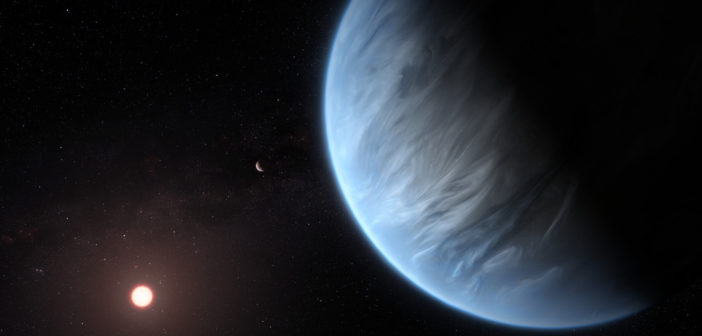One of our goals with the soon-to-launch James Webb Space Telescope (JWST) is to better characterize the atmospheres of exoplanets. But will clouds get in the way of our chances?
The Hunt for Water

As a star’s light filters through a planet’s atmosphere on its way to Earth, the atmosphere absorbs certain wavelengths depending on its composition. [European Southern Observatory]
In the search for life beyond our solar system, surface liquid water is generally considered a necessary ingredient for a habitable world — so signatures of water vapor in planet atmospheres are a prime target for transmission spectroscopy. But any planet with abundant surface water is likely to have something else, too: clouds of liquid and ice condensing in its atmosphere.
A new study led by Thaddeus Komacek (The University of Chicago) explores whether these clouds will foil our chances of detecting water vapor in the atmospheres of terrestrial exoplanets.

Transmission spectra for planets with clouds (open markers) and without clouds (closed markers), for rotation periods of 8 (orange) and 16 (blue) days. Clouds significantly mute the spectral features, especially for long-period planets. JWST’s expected noise floor is ~20 ppm. [Komacek et al. 2020]
An Obstructed View
Komacek and collaborators examine the results of three-dimensional general circulation models of tidally locked planets orbiting M-dwarf stars. The authors generate simulated transit spectra for planets with different rotation rates, incoming starlight, surface pressure, radius, and more. They then explore whether the presence of clouds in the atmospheres of these planets will impede JWST’s ability to detect the water vapor features that arise from lower in the atmosphere.
The result? Bad news. The authors find that the presence of clouds significantly mutes spectral features; when clouds are present, JWST would typically need to observe 10–100 times more transits of the planet to be able to detect the water vapor features in its atmosphere.
This impact is especially strong for slower-rotating planets. The climate models show that planets with periods longer than about 12 days form significantly more cloud cover on their daysides, due to more water vapor being carried to high altitudes. This leads to even stronger muting of these planets’ spectral features.
Hope for the Future

An artist’s illustration of the James Webb Space Telescope, set to launch in March 2021. [NASA/JWST]
There is still some hope, however. An extended mission lifetime for JWST, lowered signal-to-noise threshold for detection, or the discovery of a habitable-zone planet that JWST can monitor continuously could all push the spectral features above the telescope’s noise limit.
What’s more, since only the features from the atmosphere below the clouds will be affected, species that are well-mixed above the cloud deck may still be detectable. Even on cloudy worlds, we’re sure to have plenty to learn with JWST!
Citation
“Clouds will Likely Prevent the Detection of Water Vapor in JWST Transmission Spectra of Terrestrial Exoplanets,” Thaddeus D. Komacek et al 2020 ApJL 888 L20. doi:10.3847/2041-8213/ab6200


12 Comments
Pingback: SPACE TODAY
Pingback: From AAS NOVA: “Cloudy Challenges to Exploring Exoplanet Atmospheres” | sciencesprings
Pingback: O Desafio Das Nuvens No Estudo Da Atmosfera de Exoplanetas – A Vida Não Vai Ser Fácil Para o James Webb | Mestre Jedi
Pingback: Problemas con las nubes en la exploración de las atmósfera de los exoplanetas – Observatori Astronòmic
Pingback: Problemas con las nubes en la exploración de las atmósfera de los exoplanetas « SEDA / LIADA - RedLIADA - Cursos LIADA - Cielo del Mes - Fenómenos Astronómicos - RELEA
Pingback: Problemas con las nubes en la exploración de las atmósfera de los exoplanetas | Sección de Exoplanetas - Planetas extrasolares / LIADA Liga Iberoamericana de Astronomía
Pingback: How Will Clouds Obscure the View of Exoplanet Surfaces? - Worldika - New Platform For Explore World
Pingback: How Will Clouds Obscure the View of Exoplanet Surfaces? – Dinezh.com
Pingback: InfoBR - Seu Site de Notícias
Pingback: How will clouds obscure the view of exoplanet surfaces? – JWEasyTech
Pingback: Peering Into the Atmosphere of the Hottest Planet Known
Pingback: From AAS NOVA: “Peering Into the Atmosphere of the Hottest Planet Known” KELT-9b | sciencesprings